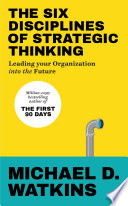

Strategic thinking is essential for organizations to navigate complex environments and achieve long-term success. It involves understanding the broader context in which a business operates, including market dynamics, competitive landscapes, and internal capabilities. This discipline encourages leaders to step back from day-to-day operations and think critically about the direction of the organization. By fostering a culture of strategic thinking, organizations can better anticipate challenges, seize opportunities, and align their resources effectively. The book emphasizes that strategic thinking is not just for top executives; it should be cultivated at all levels of the organization to create a more agile and responsive company.
Continue readingThe authors introduce a framework consisting of six disciplines that organizations must master to enhance their strategic thinking capabilities. These disciplines are: 1) Framing the Future, 2) Creating a Shared Vision, 3) Engaging Stakeholders, 4) Building Strategic Capability, 5) Aligning Resources, and 6) Learning and Adapting. Each discipline is interconnected, and together they form a comprehensive approach to strategic thinking. By systematically applying these disciplines, organizations can develop a robust strategic plan that reflects their unique context and aspirations, ensuring that all team members are aligned and working towards common goals.
Continue readingFraming the future involves identifying and analyzing the key trends and forces that will shape the business environment. This discipline encourages leaders to look beyond current challenges and envision potential scenarios that could impact their organization. By understanding the external landscape, leaders can better anticipate changes and prepare their organizations to respond effectively. The authors stress the importance of using data and insights to inform this process, as well as engaging diverse perspectives to enrich the analysis. This proactive approach to framing the future enables organizations to remain resilient and adaptable in a rapidly changing world.
Continue readingA shared vision is crucial for uniting an organization around common goals and aspirations. This discipline focuses on articulating a compelling vision that resonates with all stakeholders, including employees, customers, and partners. The authors highlight the need for leaders to communicate the vision effectively and ensure that it is understood and embraced at all levels of the organization. A shared vision serves as a guiding star, motivating team members to align their efforts and make decisions that support the overall strategic direction. Moreover, the authors emphasize the importance of revisiting and refining the vision as circumstances evolve, ensuring it remains relevant and inspiring.
Continue readingEngaging stakeholders is about building strong relationships with those who have a vested interest in the organization's success. This discipline involves identifying key stakeholders, understanding their needs and expectations, and actively involving them in the strategic process. The authors argue that effective stakeholder engagement fosters collaboration, enhances trust, and generates valuable insights that can inform strategic decisions. By involving diverse perspectives, organizations can create more innovative solutions and mitigate potential risks. The book provides practical strategies for engaging stakeholders, emphasizing that this is an ongoing process that requires continuous communication and relationship-building.
Continue readingBuilding strategic capability refers to developing the skills, processes, and systems necessary for effective strategic execution. This discipline emphasizes the importance of investing in talent development, fostering a culture of continuous learning, and establishing clear processes for strategic planning and execution. The authors highlight that organizations must cultivate a strategic mindset among employees, empowering them to think critically and contribute to the strategic process. Additionally, the book discusses the role of technology in enhancing strategic capability, such as leveraging data analytics to inform decision-making and streamline processes.
Continue readingThe final discipline, learning and adapting, underscores the necessity of being agile and responsive to change. Organizations must create mechanisms for continuous learning, allowing them to gather feedback, assess performance, and adjust strategies as needed. The authors advocate for a culture that embraces experimentation and innovation, where failures are viewed as opportunities for growth. By fostering a learning-oriented environment, organizations can remain competitive and resilient in the face of uncertainty. The book provides practical tools and frameworks for implementing effective learning processes, ensuring that organizations can adapt to new challenges and capitalize on emerging opportunities.
Continue reading